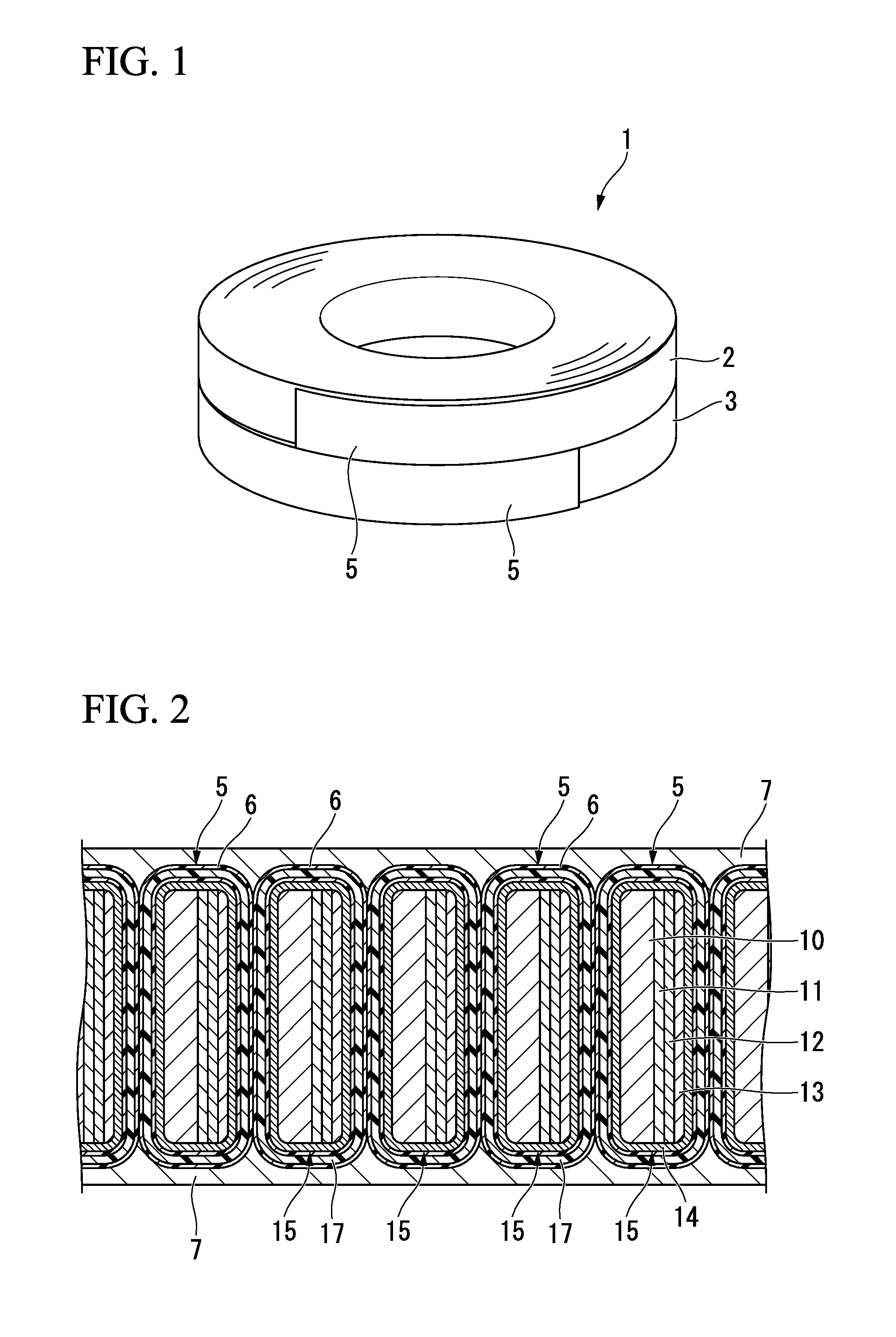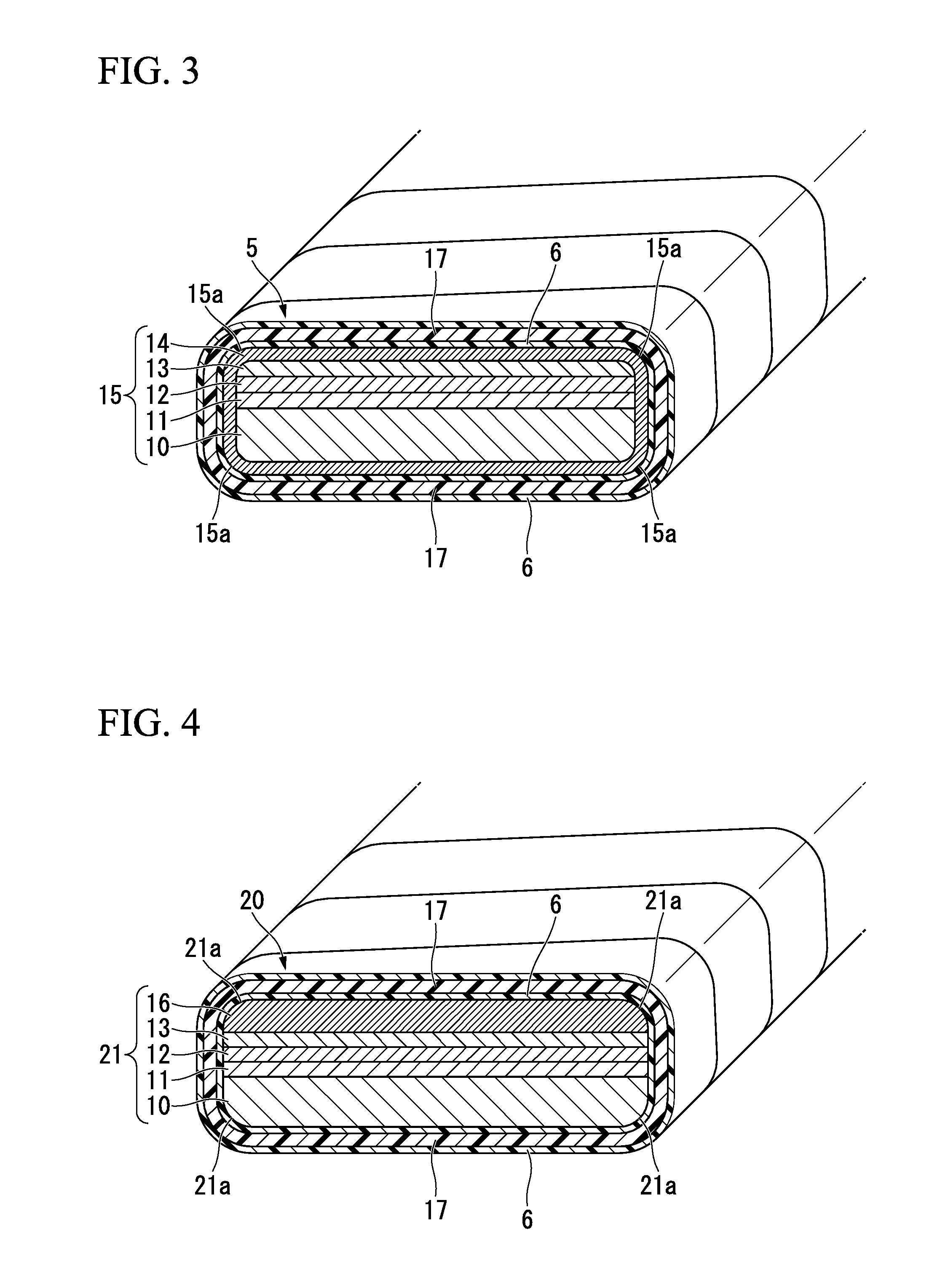Oxide superconductor wire and superconducting coil
a superconductor wire and superconducting coil technology, applied in the direction of superconducting magnets/coils, cables, magnetic bodies, etc., can solve the problems of difficult winding of the release material layer, deterioration of superconductivity,
- Summary
- Abstract
- Description
- Claims
- Application Information
AI Technical Summary
Benefits of technology
Problems solved by technology
Method used
Image
Examples
first embodiment
[0079]FIG. 1 illustrates a superconducting coil 1 which is formed by winding an oxide superconductor wire according to a first embodiment of the present invention. In this example, the superconducting coil 1 is formed as a two-layer pancake coil in which a pancake coil body 2 on an upper side and a pancake coil body 3 on a lower side are laminated.
[0080]Each of the coil bodies 2 and 3 is formed by winding a tape-shaped oxide superconductor wire 5 having a cross-sectional structure illustrated in FIG. 2 in a spiral shape such that one surface thereof is an inside surface and the other surface is an outside surface.
[0081]In the example of FIG. 1, the coil body 2 on the upper side is formed by winding the oxide superconductor wire 5 clockwise, and the coil body 3 on the lower side is formed by winding the oxide superconductor wire 5 counterclockwise.
[0082]In addition, as illustrated in FIG. 2, the oxide superconductor wire 5 is provided with a coating layer 6 described below on the out...
second embodiment
[0185]FIG. 4 is a cross-sectional perspective view illustrating part of an oxide superconductor wire for forming a superconducting coil according to a second embodiment of the present invention.
[0186]An oxide superconductor wire 20 having a cross-sectional structure illustrated in FIG. 4 includes a superconductor laminate 21 that is formed by laminating the intermediate layer 11, the oxide superconductor layer 12, the first metal stabilizing layer 13, and a second metal stabilizing layer 16 on one surface of the tape-shaped substrate 10; the insulating coating layer 17 that is provided with a coating layer and is formed so as to cover the entire outside surface of the superconductor laminate 21; and the coating layer 6 that is formed on both inside and outside surfaces of the insulating coating layer 17.
[0187]In addition, the first metal stabilizing layer 13 is laminated on only the oxide superconductor layer 12, and the second metal stabilizing layer 16 is laminated on only the fir...
third embodiment
[0212]FIG. 5 is a cross-sectional perspective view illustrating part of an oxide superconductor wire for forming a superconducting coil according to a third embodiment of the present invention.
[0213]An oxide superconductor wire 23 having a cross-sectional structure illustrated in FIG. 5 includes a superconductor laminate 25 that is formed by forming the intermediate layer 11, the oxide superconductor layer 12, and the first metal stabilizing layer 13 on one surface of the tape-shaped substrate 10 and forming a second metal stabilizing layer 24 so as to cover a circumference of the resultant; and the insulating coating layer 17 that is formed so as to cover the entire outside surface of the superconductor laminate 25.
[0214]In addition, the insulating coating layer 17 includes the coating layer 6, and the coating layer 6 is formed on both inside and outside surfaces of the insulating coating layer 17.
[0215]In this embodiment, the first metal stabilizing layer 13 is formed on only the ...
PUM
| Property | Measurement | Unit |
|---|---|---|
| critical temperature | aaaaa | aaaaa |
| thickness | aaaaa | aaaaa |
| thickness | aaaaa | aaaaa |
Abstract
Description
Claims
Application Information
 Login to View More
Login to View More - R&D
- Intellectual Property
- Life Sciences
- Materials
- Tech Scout
- Unparalleled Data Quality
- Higher Quality Content
- 60% Fewer Hallucinations
Browse by: Latest US Patents, China's latest patents, Technical Efficacy Thesaurus, Application Domain, Technology Topic, Popular Technical Reports.
© 2025 PatSnap. All rights reserved.Legal|Privacy policy|Modern Slavery Act Transparency Statement|Sitemap|About US| Contact US: help@patsnap.com



